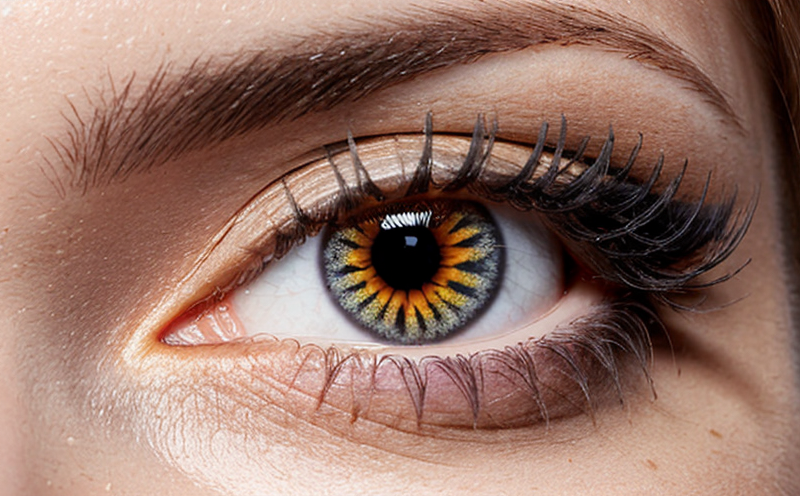Ocular Irritation Testing in Cosmetic Spray Mists
In the realm of cosmetic product development and regulatory compliance, ensuring ocular safety is paramount. This is particularly critical when dealing with cosmetic spray mists, which can be directly applied to the eyes or come into close contact with them during use. The potential for eye irritation necessitates rigorous testing protocols to safeguard consumer health and meet stringent international standards.
Eye irritation tests are conducted using various methodologies depending on the type of product being evaluated. For cosmetic spray mists, the test involves exposure of human corneal epithelial cells or isolated rabbit eyes to a sample of the mist. The aim is to determine if there is any damage or inflammation caused by the substance.
The testing process begins with careful preparation of the cosmetic formulation in its intended delivery format. This includes ensuring that all active ingredients are present at their labeled concentrations and that the spray characteristics (e.g., particle size, distribution) mimic real-world usage conditions. Once prepared, aliquots of the mist are then sprayed onto live rabbit eyes or human corneal cells under controlled laboratory conditions.
The rabbits used in these tests are specifically selected for their sensitivity to irritants. After exposure, the eyes are examined for signs of inflammation such as redness, swelling, or discharge. Additionally, fluorescein staining may be applied to assess any disruption to the corneal epithelium. The results from these observations form part of the final report.
For human corneal cell cultures, viability assays and cytotoxicity tests are performed post-exposure to evaluate cellular health and function. These data points help determine whether the cosmetic spray mist is safe for consumer use without causing adverse effects on ocular tissues.
The results of these tests are crucial not only for ensuring product safety but also for meeting regulatory requirements set forth by organizations like the European Union Cosmetics Regulation, FDA (Food and Drug Administration), and ISO standards. Compliance with such regulations ensures that products can be marketed globally without fear of recalls or legal action.
| Test Method | Description |
|---|---|
| In vivo Test on Rabbit Eyes | Exposure of live rabbit eyes to the cosmetic spray mist followed by observation for signs of irritation. |
| In vitro Test using Human Corneal Cell Cultures | Viability and cytotoxicity assays performed post-exposure to determine cellular health. |
Scope and Methodology
The scope of ocular irritation testing for cosmetic spray mists encompasses a range of parameters aimed at assessing the potential for eye damage. This includes evaluating the physical properties of the mist, such as particle size distribution, which can significantly influence how the substance interacts with the eye upon application.
- Particle Size Distribution: Ensuring that particles are within safe limits to prevent ocular injury.
- Formulation Stability: Checking for stability over time to maintain consistent performance.
The methodology involves several key steps:
- Preparation of the cosmetic formulation in its intended spray format.
- Exposure of test specimens (rabbit eyes or human corneal cells) to the mist under controlled conditions.
- Observation and evaluation of any signs of irritation or damage post-exposure.
The results from these tests are compiled into detailed reports that provide comprehensive insights into the ocular safety profile of the cosmetic spray mist. These reports serve as critical documentation for regulatory submissions and internal quality assurance purposes.
International Acceptance and Recognition
- The European Union Cosmetics Regulation mandates that all cosmetics sold within its borders undergo rigorous safety testing, including ocular irritation tests for spray mists.
- In the United States, the FDA requires similar safety assessments to ensure consumer protection. Compliance with these standards is essential for manufacturers aiming to sell their products in both regions.
ISO and ASTM standards provide additional guidance on best practices for conducting these tests consistently across different laboratories worldwide. Adherence to these guidelines ensures that results are comparable and reliable, further enhancing the credibility of the testing process.
Environmental and Sustainability Contributions
Ocular irritation testing plays a vital role in promoting environmental sustainability by ensuring that cosmetic spray mists do not contain harmful substances that could cause long-term damage to human eyes. By minimizing the risk of accidental exposure, these tests contribute indirectly to reducing waste generation associated with discarded products.
- Reduction in Consumer Complaints: Fewer reports of eye injuries lead to reduced demand for return or replacement of faulty products.
- Enhanced Reputation: Companies demonstrating commitment to ocular safety enhance their reputation among consumers who prioritize product quality and safety.
Beyond direct benefits, this approach fosters a culture of responsibility within the industry. As more companies adopt robust testing practices, there is an overall improvement in the standard of cosmetic products available on the market.





